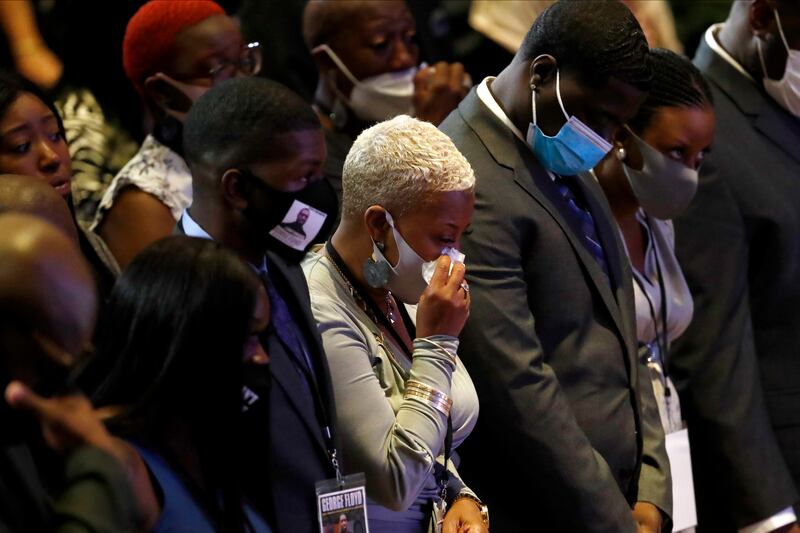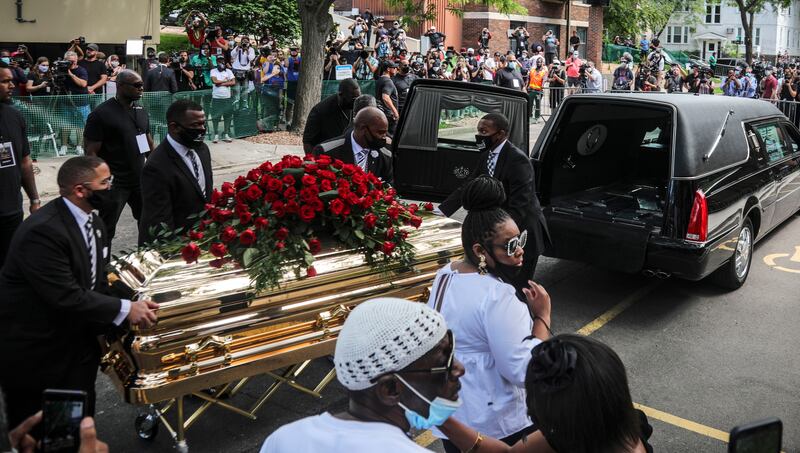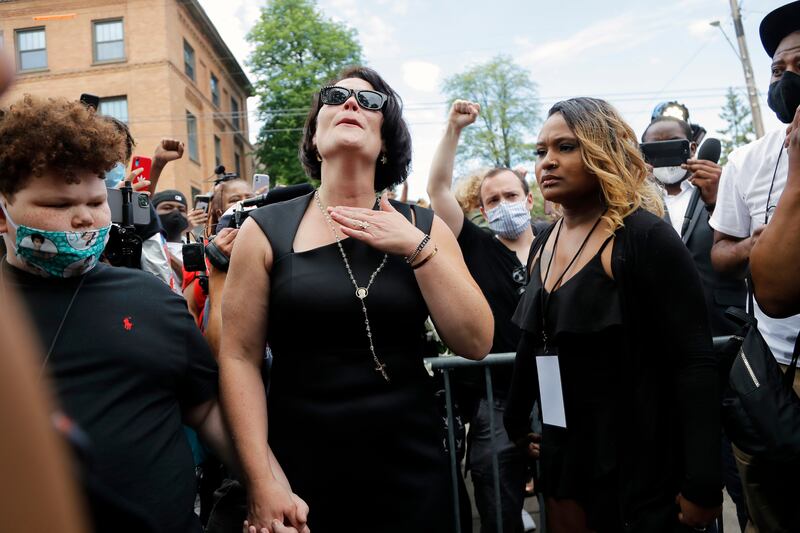SALT LAKE CITY — After the Rev. Al Sharpton called on attendees at George Floyd’s Minneapolis funeral to stand still and bow their heads on Thursday, thousands watching the memorial service around the world took part in the 8 minute and 46 second period of silence. It was a collective display of mourning in a week marked by national grief, not just for the death of one man but for centuries of racial discrimination in America.
Psychologist Amber Hewitt, director of health equity at Families USA, a nonpartisan consumer health care advocacy organization, says the psychology of grief can help us understand the different ways people around the world are responding to news of police brutality and racial injustice.
In every state and on every continent, protesters have come together, often marching, chanting, holding signs and listening to speeches by black community leaders. While the vast majority of protests have been peaceful, dozens of cities have experienced violence, vandalism and the destruction of property. Among calls for peace and reform, countless tears have been shed. Some people are seeking therapy, others are spending time with close family and friends. For everyone affected, the grieving process takes a different form.
On Saturday, Floyd’s family held another memorial filled with song and prayer in North Carolina. A memorial service is planned for Houston on Monday. With protests in some areas growing in size, the emotional response to Floyd’s death does not appear to be waning.
“The mourning that we are seeing now is tied to generations of institutional racism and violence,” said Hewitt, who is black. “We are not only grieving and mourning Mr. Floyd’s loss but how this is a symbol of not seeing the humanity of people.”
According to data compiled by Mapping Police Violence of all police killings in the U.S. in 2019, black Americans were 2.5 times more likely to be killed by police than white Americans. According to the organization’s data, 99% of all officers involved in police killings did not face criminal charges.
“I think the anger — or rage may be a more appropriate word in this context — that the black community is experiencing is a natural part of the grieving process,” Hewitt said. “If you aren’t feeling angry, to me that’s the scary part — that you could look and see what’s happening, and not feel or have emotions evoked.”

Stages of grief
At home in Washington, D.C., Diallo Brooks, a black father of three, joined other observers Thursday in sitting quietly for 8 minutes and 46 seconds, the fatal amount of time that a Minneapolis police officer kept his knee pressed to Floyd’s neck.
As the senior director of outreach and public engagement at People for the American Way, a progressive advocacy organization, Brooks participated with the leaders of other civil rights and racial justice groups in a national day of mourning.
“There’s a lot of emotions for a lot of folks,” said Brooks, adding that the past two weeks have been “a roller coaster of emotions” for him personally.
“We have to recognize the individuals who have passed away, not only in the incident in Minnesota, but in incidents all over the country,” Brooks said. “Folks are mourning for a larger community, for lost opportunity. They are mourning but hopeful that we can use this moment to push us towards positive change.”
Knowyourgrief.org lists more than a dozen types of grief, including cumulative grief, or grief which occurs when multiple losses are experienced within a short period of time, and collective grief, “a loss which is experienced by a group of people together.”
The most well-known model for understanding grief is Swiss American psychiatrist Elisabeth Kübler-Ross’ five stages: denial, anger, depression, bargaining and acceptance. But according to Hewitt, the grieving process looks different for each individual. A person usually doesn’t go through the five phases in order. Instead, they may repeatedly cycle through a variety of emotions captured in the model.
Hewitt noted that expressing anger is an important part of grief and is critical to moving forward. Anger also signals that people are not in denial and that they recognize the injustices that have compounded over generations, she said. This may be especially relevant to understanding the protests.
But the five stages of grief are not a perfect parallel to what we are seeing in the world right now, said Hewitt, primarily because ‘acceptance’ is not a logical conclusion.
“Yes, people are angry but I also see people calling for change. They’re channeling that anger to explore options for hope and change.”
In counseling sessions over the past two weeks, Washington, D.C.-based psychologist Satira Streeter says she has seen her clients express a whole range of emotions from frustration and anger to sadness, hopelessness and despair. Streeter, who is black, is the founder and executive director of Ascensions Psychological Services, a nonprofit counseling center that serves the local African American community. She said a number of her clients who were making progress with anxiety and depression have regressed due to recent events. Streeter said she has also had to confront her own grief.
“I don’t know George Floyd, but I feel for his family, and I feel for his 6-year-old daughter who I saw on the news. She now joins the ranks of little black girls having to deal with fatherlessness when it didn’t have to be that way,” said Sreeter, who has two sons, ages 9 and 10. “When these things happen, not only does it trigger your past pain, it connects you more with the pain of others. You feel it all and you feel it all intensely.”
Streeter emphasized the heavy toll that persistent trauma can take, not only on a person’s mental health, but on their physical health as well, with negative effects on the cardiovascular, immune, gastrointestinal and musculoskeletal systems. When an entire community is impacted, the suffering is amplified, she said.

Healing
On Friday, hundreds of people wearing black showed up in front of the Camping World Stadium in Orlando, Florida, for a peaceful walk of mourning. Pastor Derrick McRae of Experience Christian Center is one of several religious leaders who participated in the mile-long march along with law enforcement officers and city officials. As they walked, they recited scriptures and prayed, Pastor McRae said.
The walk was not a protest, but rather an opportunity to mourn the lives lost to police brutality and social injustice, according to Pastor McRae.
In his work leading a congregation of 2,400 members, 99% of whom are black, Pastor McRae said he has counseled many individuals who have dealt with the death of a loved one, or another tragic loss. He’s seen some who have struggled to heal as they are forced to focus on logistical problems like managing a house, paying the bills and taking care of children, without taking proper time to grieve.
“You can lock yourself into getting things done that you never deal with what you feel and how you felt at the loss of something,” Pastor McRae said. “And I believe that’s where our African American community is. The reality is this is nothing new. And we’ve been suppressing the hurt and pain for so many years.”
As a pastor, McRae said he’s also learned that everyone grieves differently.
“I’m not in agreement at all with the looting that is taking place,” Pastor McRae said. “But at the same time, I understand why some people are doing those things.”
“As a nation, we can’t tell the black population how to grieve. Don’t give me an answer for if you can’t give me an answer for how to address this ill,” Pastor McRae added.
Friday’s walk ended in front of the Amway Center, where the NBA’s Orlando Magic play, with a ceremony that involved speeches by faith leaders and law enforcement officials. Orange County Sheriff John Mina apologized to the crowd for injustices that have been committed by law enforcement against people of color in the community. He promised to hold law enforcement accountable to the highest ethical and professional standards and pledged to implement ideas from community members.
Then the crowd kneeled together in prayer.
“This wound may be reopened, that is a very possible scenario,” said Pastor McRae. “But it’s easier to deal with an open wound when we know that it’s possible to get to a place of healing.”


